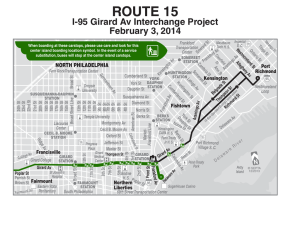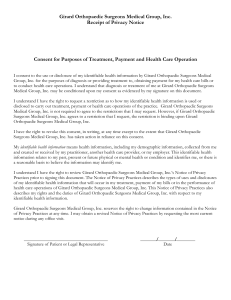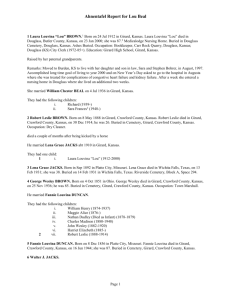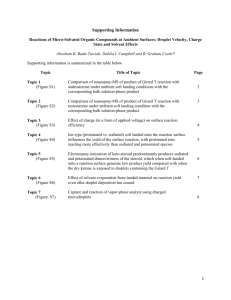pennsylvania historic resource survey form - data sheet
advertisement
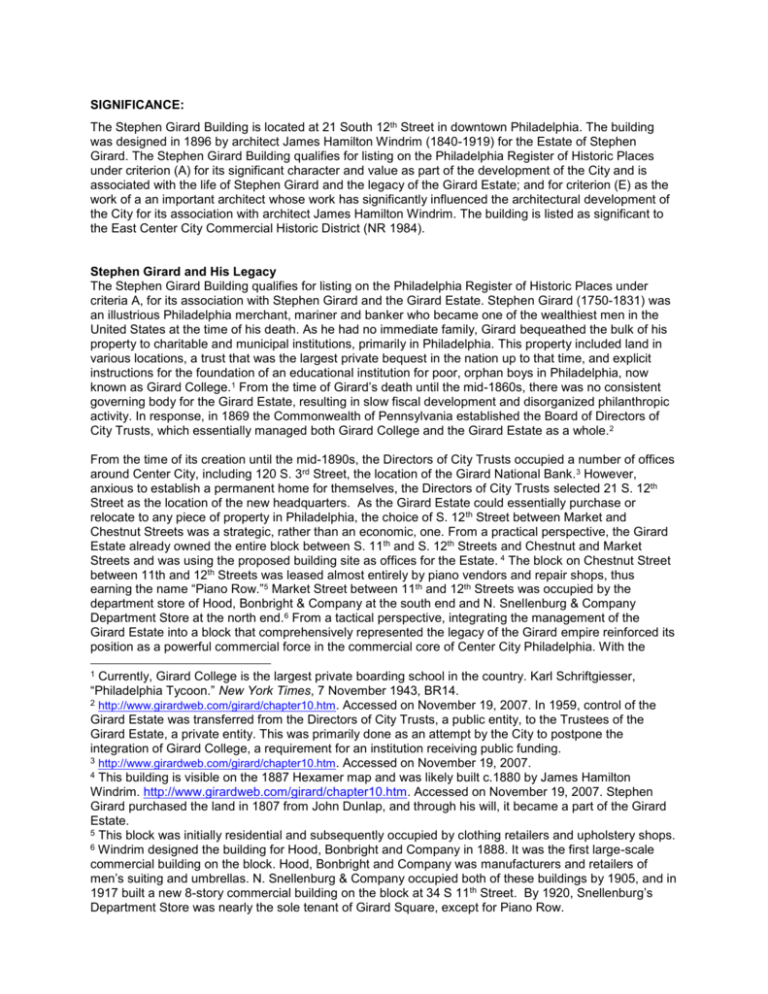
SIGNIFICANCE: The Stephen Girard Building is located at 21 South 12th Street in downtown Philadelphia. The building was designed in 1896 by architect James Hamilton Windrim (1840-1919) for the Estate of Stephen Girard. The Stephen Girard Building qualifies for listing on the Philadelphia Register of Historic Places under criterion (A) for its significant character and value as part of the development of the City and is associated with the life of Stephen Girard and the legacy of the Girard Estate; and for criterion (E) as the work of a an important architect whose work has significantly influenced the architectural development of the City for its association with architect James Hamilton Windrim. The building is listed as significant to the East Center City Commercial Historic District (NR 1984). Stephen Girard and His Legacy The Stephen Girard Building qualifies for listing on the Philadelphia Register of Historic Places under criteria A, for its association with Stephen Girard and the Girard Estate. Stephen Girard (1750-1831) was an illustrious Philadelphia merchant, mariner and banker who became one of the wealthiest men in the United States at the time of his death. As he had no immediate family, Girard bequeathed the bulk of his property to charitable and municipal institutions, primarily in Philadelphia. This property included land in various locations, a trust that was the largest private bequest in the nation up to that time, and explicit instructions for the foundation of an educational institution for poor, orphan boys in Philadelphia, now known as Girard College.1 From the time of Girard’s death until the mid-1860s, there was no consistent governing body for the Girard Estate, resulting in slow fiscal development and disorganized philanthropic activity. In response, in 1869 the Commonwealth of Pennsylvania established the Board of Directors of City Trusts, which essentially managed both Girard College and the Girard Estate as a whole.2 From the time of its creation until the mid-1890s, the Directors of City Trusts occupied a number of offices around Center City, including 120 S. 3rd Street, the location of the Girard National Bank.3 However, anxious to establish a permanent home for themselves, the Directors of City Trusts selected 21 S. 12th Street as the location of the new headquarters. As the Girard Estate could essentially purchase or relocate to any piece of property in Philadelphia, the choice of S. 12 th Street between Market and Chestnut Streets was a strategic, rather than an economic, one. From a practical perspective, the Girard Estate already owned the entire block between S. 11th and S. 12th Streets and Chestnut and Market Streets and was using the proposed building site as offices for the Estate. 4 The block on Chestnut Street between 11th and 12th Streets was leased almost entirely by piano vendors and repair shops, thus earning the name “Piano Row.”5 Market Street between 11th and 12th Streets was occupied by the department store of Hood, Bonbright & Company at the south end and N. Snellenburg & Company Department Store at the north end.6 From a tactical perspective, integrating the management of the Girard Estate into a block that comprehensively represented the legacy of the Girard empire reinforced its position as a powerful commercial force in the commercial core of Center City Philadelphia. With the 1 Currently, Girard College is the largest private boarding school in the country. Karl Schriftgiesser, “Philadelphia Tycoon.” New York Times, 7 November 1943, BR14. 2 http://www.girardweb.com/girard/chapter10.htm . Accessed on November 19, 2007. In 1959, control of the Girard Estate was transferred from the Directors of City Trusts, a public entity, to the Trustees of the Girard Estate, a private entity. This was primarily done as an attempt by the City to postpone the integration of Girard College, a requirement for an institution receiving public funding. 3 http://www.girardweb.com/girard/chapter10.htm . Accessed on November 19, 2007. 4 This building is visible on the 1887 Hexamer map and was likely built c.1880 by James Hamilton Windrim. http://www.girardweb.com/girard/chapter10.htm. Accessed on November 19, 2007. Stephen Girard purchased the land in 1807 from John Dunlap, and through his will, it became a part of the Girard Estate. 5 This block was initially residential and subsequently occupied by clothing retailers and upholstery shops. 6 Windrim designed the building for Hood, Bonbright and Company in 1888. It was the first large-scale commercial building on the block. Hood, Bonbright and Company was manufacturers and retailers of men’s suiting and umbrellas. N. Snellenburg & Company occupied both of these buildings by 1905, and in 1917 built a new 8-story commercial building on the block at 34 S 11th Street. By 1920, Snellenburg’s Department Store was nearly the sole tenant of Girard Square, except for Piano Row. completion of City Hall at Broad and Chestnut Streets in 1871, the surrounding blocks became the center of the commercial district in Philadelphia, and new ornate “skyscrapers” were completed every year. These buildings represented the American business boom of the Gilded Age, and Philadelphia’s role as one of the top financial centers in the country, following New York and Boston. 7 The new headquarters building at 21 S. 12th Street followed in this tradition and operated as the centerpiece of this significant block and as the home base of the prominent Girard Estate. The Girard Estate Directors commissioned James Hamilton Windrim to design a 13-story building at 21 South 12th Street in 1896. Doyle & Doak were hired as the contractors for the project.8 Although a 13story building was far more space than the Directors of City Trusts needed exclusively for their offices, they saw the building as an opportunity to maximize their real estate interests. When the building was officially opened on December 18, 1897 the office space was almost fully rented. 9 Between 1896 and 1912, the building served as the headquarters of the Girard Estate. After 1912, the Board of Directors moved to the Lafayette Building at 433-441 Chestnut Street. From that time until present day, the building on N. 12th Street has remained in the possession of the Girard Estate and has continually operated as rental office space.10 James Hamilton Windrim, Architect The Stephen Girard Building also qualifies for listing on the Philadelphia Register of Historic Places under criteria E, for its association with the illustrious Philadelphia architect James Hamilton Windrim. James Hamilton Windrim, a native Philadelphian, designed civic, governmental and commercial buildings throughout Philadelphia during his long career. After graduating from Girard College in 1856, he briefly worked for architect John Notman (1810-1865).11 By 1867, Windrim had opened his own office at 129 S. 7th Street. Windrim first gained famed through his designs of the Masonic Temple (1867, extant, NR 1971), the Academy of Natural Sciences Building (1868, extant), Agricultural Hall (1876, demolished), the Bergdoll Mansion (1890, extant, NR 1976) and the North American Building on S. Broad Street (1899, extant). In 1871, Windrim was appointed the official architect of the Girard Estate and designed many buildings both on the Girard College campus and for the Estate throughout the city. It was in this capacity, as Philadelphia’s best funded architect, that Windrim left an indelible mark on the landscape of commercial Philadelphia. His work for the Girard Estate is found in the Lafayette Building (1907, extant) at the northeast corner of 5th and Chestnut Streets, the N. Snellenburg & Company Department Store (1897, demolished) at the southeast corner of 12th and Market Streets, as well as alterations to the First Bank of the United States (also known as the Girard National Bank built in 1795, extant, NR 1987, NHL 1987). In 1889, Windrim was made Supervising Architect of the United States Treasury, and from 1891 to 1895, he was the Director of Public Works for Philadelphia. From 1895 until his death, Windrim resumed private practice with the partnership of his son, John Torrey Windrim (18661934). The Stephen Girard Building at 21 S. 12th Street is the earliest expression of Windrim’s mature style and a set the precedent for his aesthetic until the end of his career. Under Notman’s early influence, Windrim absorbed his Classical approach, but replaced Notman’s more Revivalist aesthetic with a more modern, Beaux-Arts application. The Beaux-Arts style was in perfect accord with the image that his nouveau riche, industrialist patrons were trying to project. In Windrim’s early work, such as Academy of Natural Sciences 7 George Englehardt, Philadelphia, Pennsylvania: The Book of its Bourse and Cooperating Bodies. Philadelphia: Lippincott Press, 1899, 200-203. 8 William J. Doyle and James G. Doak worked on such prominent Philadelphia buildings as the demolished Bulletin Building (c.1906) at 1315-1325 Filbert Street and on alterations for the Land Title Bank and Trust Company Building (1897) at 1400-1408 Chestnut Street and the Real Estate Title and Trust Company Building (1899) at 1340-1350 Chestnut Street. 9 http://www.girardweb.com/girard/chapter10.htm . Accessed on November 19, 2007. 10 The building’s tenants included the Bell Telephone Company and the Charter Bank of Philadelphia. 11 This was the first graduating class of Girard College. Building, a Classical vocabulary can be seen in the contrasting quoining and the balustraded cornice. By the mid-1890s, Windrim’s comprehensive Beaux-Arts approach is evident in such buildings as the Jefferson Medical College (1896, demolished) at the northwest corner of 10th and Walnut Streets, which had quoining, a strong rusticated base, decorative cornices, and heavy pedimented lintels. However, it is not until the Stephen Girard Building (1896, extant), the Commonwealth Title and Trust Company Building (1901, extant), the Mariner and Merchant Building (1901, demolished) and the Lafayette Building (1907, extant) that Windrim fully integrates the Classical style and Beaux-Arts elements with the more contemporary program of the base, shaft and capital design. All of these buildings have rusticated bases with heavy cornices and decorative stringcourses, as well as other decorative elements, such as pedimented lintels, prominent porticoes and accenting balconies. However, in between these features are distinctive spans of elevations with strong verticals creating the sense of a column shaft. By combining these seemingly diverse components of a “Beaux-Arts skyscraper”, Windrim was able to materialize his clients’ progressive agendas with an aesthetic that would establish them as the long-standing elite of Philadelphia.
